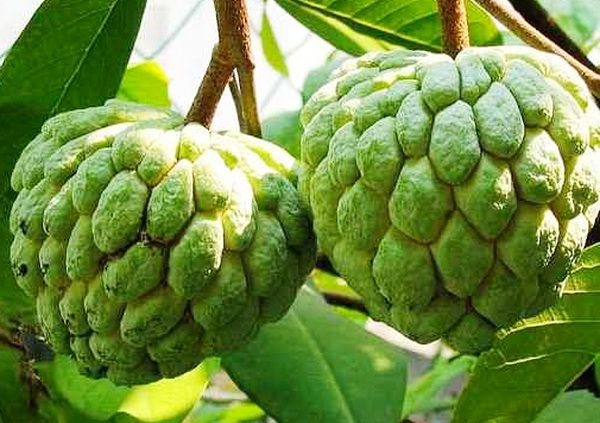Sugar apple is a fruit tree that arouses keen interest among gourmets and people who want to learn more about exotic representatives of tropical flora. The fruit of the tree is attractive by its unusual appearance and taste., rich in chemical composition, on the basis of which numerous recipes of beauty and health are created.
Table of contents
Biological plant description
The biological name of the plant is Annona scaly. It is a fruit crop developed in the countries of Oceania and Indochina, in South America, China, India and in tropical regions of Africa. The region of origin of the fruit tree is unknown, presumably the territory adjacent to the Caribbean Sea.
Tree structure
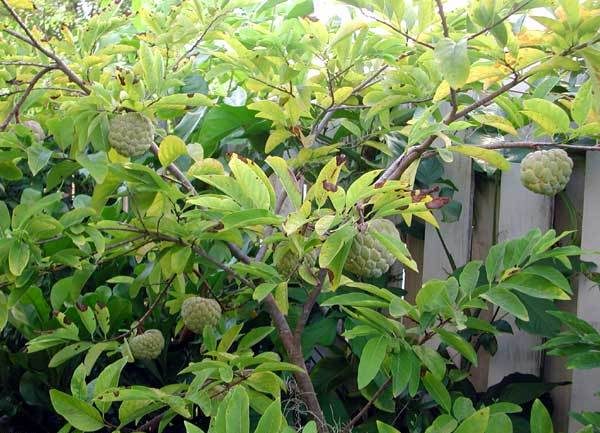
A sugar apple is a fruit tree whose growth ranges from 3 to 6 m. The branches of the tree are low and grow from a strong trunk. The main shoots branch into smaller ones with numerous pubescent cuttings, in which two rows of matt-green elongated leaves are located. When rubbing between the fingers, the leaves of the tree exude aroma with notes of vanilla. Due to such a structure, a magnificent zigzag crown is formed near the tree.
Bloom

The flowers of the fruit tree are formed singly or in a group of 2-4 pieces from the base of the petiole. The elongated shape of the flower is formed from three fleshy outer petals, within which three more smaller ones are hidden. The color of flowers is greenish-yellow, at the base there is a purple spot. The flowers of the fruit tree are quite large and reach a length of 2.5 to 4 cm. They open up only for a short period of time for insects to enter the fertilization phase.
Fruit
The fruit of the sugar apple complex structure. It consists of a plurality of segments assembled together, each of which contains an oblong seed of dark brown color from 1 to 1.5 cm in length. Pulp - fibrous, juicy and fragrant, during full ripening, it acquires a creamy consistency, resembling cream in taste. The peel is pale green, may have a grayish and bluish shades, in overripe fruits it gets a purple hue. It is a fruit of a rounded shape, reaching a length of up to 10 cm and gaining weight up to 350 g.
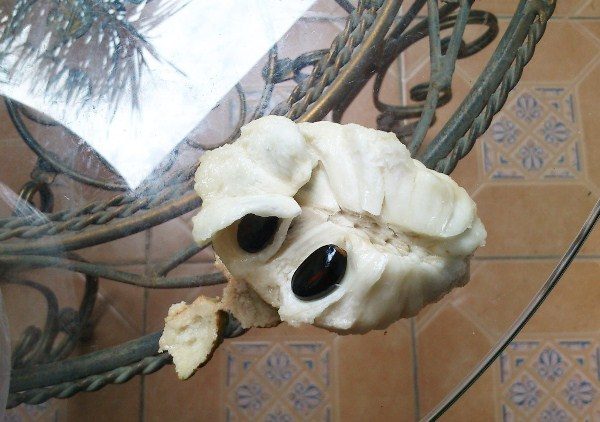
Technical ripening of fruits, depending on the region, lasts from June to September. Sugar apple is stored very little, over-ripe fruit begin to crack the peel and leak out the flesh. Therefore, the fruits of the tree are harvested before ripening; this allows preserving the appearance and quality of the fruit for export to other countries or for sale in the markets of yves and restaurants.From one adult tree is collected from 100 to 150 fruits.
Fruit composition of sugar apple
The fruits of little-known in our regions are widely used in cooking, cosmetology, and traditional medicine in the countries where they are cultivated. It's hard not to pay attention to the rich chemical composition of fruitsin which in large quantities are concentrated:
- vitamins groups B, A, C, PP;
- minerals: phosphorus, sodium, potassium, magnesium and calcium;
- irreplaceable amino acids: lysine, tryptophan, methionine;
- useful trace elements: iron, copper, selenium and zinc.
Oleic, stearic and linoleic acids are present in small quantities.

100 g of the pulp of the fruits of Annona scaly contain:
- water 73.23 g;
- carbohydrate 23.64 g;
- proteins 2.06 g;
- fats 0,29 g
The energy value of the product is 94 kcal.
Useful properties of Annona scaly
Bioactive compounds contained in the flesh of the fetus, a beneficial effect on the entire body. When the product is consumed, the body receives nutrients for beneficial microflora.that helps eliminate pathogenic bacteria. Liver function stabilizes and the increased acidity in the gastrointestinal tract decreases.
Collected in the fruits of Annona mineral complex has a positive effect on the formation of blood cells and the activity of the cardiovascular system. The product contributes to the regulation of blood glucose levels, and therefore is especially valuable for the diabetic diet.
The fruit contains a large amount of B vitamins, without which the growth of new collagen fibers and tissue renewal of all body structures is impossible. Thanks to these processes, the skin looks taut, hair and nails are distinguished by their strength and healthy shine.
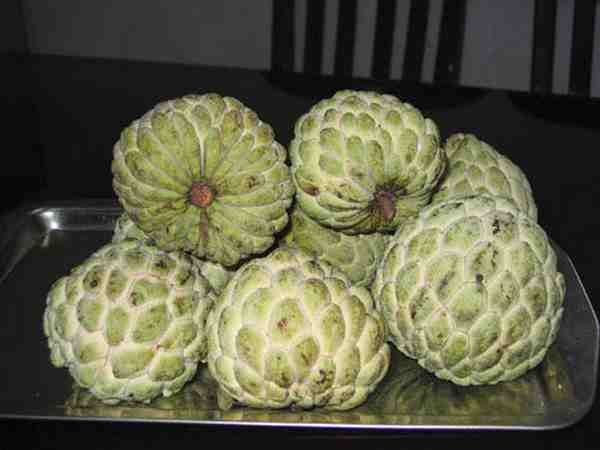
Essential Amino Acid - Tryptophan stimulates the synthesis of the hormone serotonin, which improves the quality of sleep and emotional background. Lysine - necessary for the remodeling of bones in childhood and improve short-term memory. Methionine activates the processing of fats and increases the body's resistance to toxins.
The harm of this fruit to the body
The greatest danger to the body when eating fruit comes from the seeds. They contain a large concentration of alkaloids, which act as a toxin, causing severe poisoning.
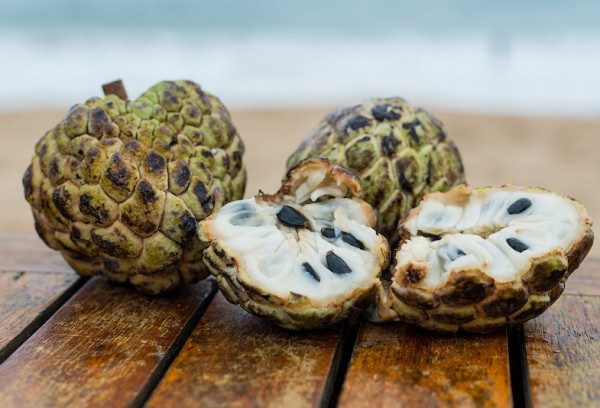
It is not recommended to use fruits during pregnancy. They contain a large amount of calcium, an overabundance of which negatively affects the development of the baby and leads to complications during childbirth.
The value of the sugar apple in medicine
All parts of the fruit tree have healing properties.which are widely used in alternative medicine, mainly by folk healers of India.More recently, scientists from this country made a phytopharmacological analysis of the fruit tree, which confirmed the high healing properties for the treatment and prevention of serious pathologies - diabetes and malignant tumors.
In addition, infusions and decoctions from different parts of the fruit tree have anti-inflammatory, antispasmodic and antipyretic properties, which allows them to be used in the symptomatic treatment of many infectious and viral diseases. The fruits of the sugar apple have regenerating and wound-healing properties and are often used to treat traumatic, ulcerative and burn wounds.
The seeds and leaves of the plant contain essential oils - effective insecticides. Infusions and decoctions of these parts of the sugar apple are most often used to combat head lice.More concentrated extract is used as a deterrent against blood-sucking insects.
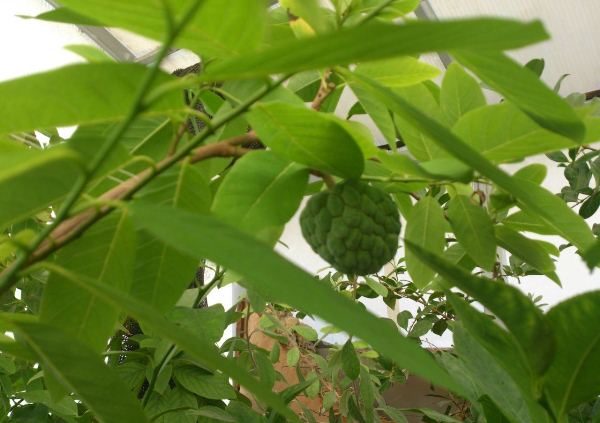
A decoction of fruits, roots and bark contains a large amount of tannin and phenolIt has an astringent effect on the digestive tract. This property of the plant is used to treat dysentery. Ground young fruits effectively treat gastrointestinal infections.
The pulp of immature fruits, mixed with salt, is applied to local edema, frequent satellites of rheumatic and varicose diseases. This mixture draws all the extra fluid from the extracellular tissues, which prevents the formation of blood clots in the vessels and restores the optimal microcirculation of substances in their walls.
Sugar apple seeds contain up to 49% non-drying oil, which is used in soap making. Soap from sugar apple oil is hypoallergenic and has high moisturizing properties.
Sugar apple in cooking
The chefs of many gourmet restaurants enjoy the delicious and unfamiliar taste of the fruit to a wide audience. Annona fruits are self-sufficient and can be served as a dessert after a hearty meal.. For this, the fruit is cut in half and served with a dessert spoon.

The most popular is sugar-based ice cream, which is often served in restaurants in the Indochina countries. Tastes of fruit are combined with milk, and the combination of these products in a cocktail will not leave anyone indifferent. In the Philippines, made a dessert wine from the fruit of the sugar apple.
Tea brewed with Annona leaves has a mild sedative and cooling properties, and will be most pleasant on a hot afternoon. Fruit pulp can be added to sweet sauces for dessert or poultry. The alkali-treated sugar tree seed oil is included in many products.
The combination of exotic taste, fragrant aroma and beneficial properties for the human body make sugar apple one of the most interesting tropical fruits. Studies of the chemical composition of the plant are still being conducted in the laboratories of many countries and, undoubtedly, will give results that reveal the full potential of Annona scaly.
